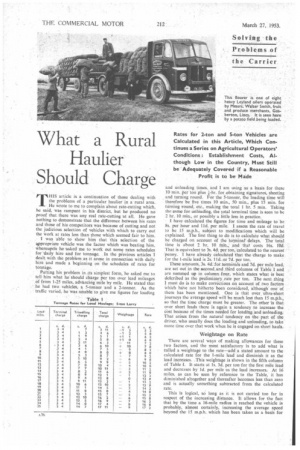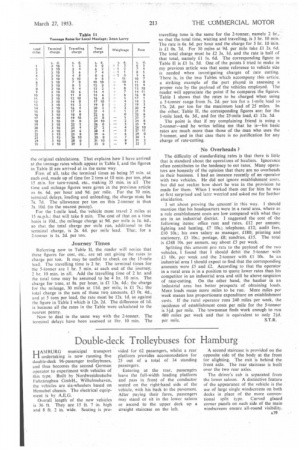What a Rural Haulier Should Charge
Page 54

Page 57

If you've noticed an error in this article please click here to report it so we can fix it.
Rates for 2-ton and 5-ton Vehicles are Calculated in this Article, Which Continues a Series on Agricultural Operators' Conditions : Establishment Costs, Although Low in the Country, Must Still be Adequately Covered if a Reasonable Profit is to be Made
THIS article is a continuation of those dealing with the problems of a particular haulier in a rural area. He wrote to me to complain about rate-cutting which, he said, was rampant in his district, but he produced no proof that there was any real rate-cutting at all. He gave nothing to demonstrate that the difference between his rates and those of his competitors was because of cutting and not the judicious selection of vehicles with which to carry out the work at rates less than those which seemed fair to him.
I was able to show him that this selection of the 43propriate vehicle was the factor which was beating him, whereupon 'he -asked me to work out some rates schedules for 'daily hire and for tonnage. In the previous articles I dealt with the problem as 'it arose in connection with daily hire and made a beginning on the schedules of rates for tonnage.
Putting his problem in its simplest form, he asked me to tell him what he should charge per ton over lead mileages of from 1-25 miles, advancing mile by mile. He stated that he had two vehicles, a 5-tonner and a 2-tonner. As the traffic varied, he was ,unable to give me figures for loading and unloading times, and I am using as a basis for these 10 min. per ton plus 1-hr. for obtaining signatures, sheeting and turning round. For the 5-tonner, the loading time will therefore be five times 10 min., 50 min., plus 15 min. for turning round, etc., making the total 1 hr. 5 min. Taking tha same for unloading, the total terminal time is seen to be 2 hr. 10 min., or possibly a little less in practice.
I have calculated the figures for time and mileage to be 8s, per hour and lid, per mile. I assess the Tate of travel to be 15 m.p.h., subject to modifications which will be explained. The first thing to do is to calculate what should be charged on account of the terminal' delays. The total time is about 2 hr. 10 Mitt.; and that costs 16s. 10d. That is equivalent to 3s. dd. per ton, calculated to the nearest 'penny. I have already calculated that the charge to make for the 1-mile lead is 2s. 11d. or 7d. per ton.
These amounts, 35. 4d..foilerminals and 7d. per mile lead, are set out in the second_and.third columns of Table I and are summed up in column four, which stales what is best defcribed as the preliminary rate per tort The next thing I must do is to make corrections on account of two factors Which have not hitherto been considered, although' one of them has been mentioned. One is that over ultra-short journeys the average speed will be much less than 15 m.p.h., so that the time charge must be greater. The other is that over short leads there is again a tendency to increase the cost because of the times needed for loading and unloading. That arises from the natural tendency on the part of the driver, who usually does the loading and unloading, to take more time over that work when he is engaged on short hauls.
Weightage on Rate
There are several ways of making allowances for these two factors, and the most satisfactory is to add what is tailed a weightage to the rate—add a stated amount to the calculated rate for the 1-mile lead and diminish it as the lead increases. .This weightage is shown in the fifth column of Table I. It starts at Is. 3d. per ton' for the first mile lead and decreases by Id. per mile as the lead increases. At 16 miles, as can be seen by reference to the Table, it has diminished altogether and thereafter becomes less than zero and is actually something subtracted from the calculated rate.
This is logical, so long as it is not carried too far in respect of the increasing distance. It allows for the fact that by the time a 16-mile radius is reached the vehicle is probably, almost certainly, increasing the average speed beyond the 15 m.p.h. which has been taken as a basis for the original calculations. That explains how I have arrived at the tonnage rates which appear in Table I, and the figures in Table II arc arrived at in the same way.
First of all, take the terminal times as being 35 min. at each end, made up of time for 2 tons at 10 min. per ton, plus 15 min. for turn-round, etc., making 35 min. in all The time and mileage figures were given in the previous article as Gs. 6d. per hour and 9d. per mile. For the 70 min. terminal delays, loading and unloading, the charge must be 7s. 7d. The allowance per ton on this 2-tonner is thus 3s. lOd. (to the nearest penny).
For the I-mile lead, the vehicle must travel 2 miles at 15 m.p.h.; that will take 8 min. The cost of that on a time basis is 10d., the mileage charge at 9d. per mile is Is. 6d., so that the total charge per mile run, additional to the terminal charge, is 2s. 4d. per mile lead. That, for a 2-tonner is Is. 2d. per ton.
Journey Times
Referring now to Table 11, the, reader will notice that these figures for cost, etc., are set out giving the rates to charge per ton. It may be useful to check on the 15-mile lead. The travelling time is 2 hr. The terminal times for the 5-tonner are 1 hr. 5 min. at each end of the journey, 2 hr. 10 min. in all. Add the travelling time of 2 hr. and the total time may be assumed to be 4 hr. 10 min. The charge for time, at 8s. per hour, is £1 13s. 4d.; the charge for the mileage, 30 miles at Ild, per mile, is £1 7s.; the total charge is the sum of those two amounts. £3 Os. 4d., and at 5 tons per load, the rate must be 12s. Id, as against the figure in Table I which is 12s. 2d. The difference of Id. is because all the rates in the Table were calculated to the nearest penny.
Now to deal in the same way with the 2-tonner. The terminal delays have been assessed at lhr. 10 min. The
travelling time is the same for the 2-tonner, namely 2 hr., so that the total time, waiting and travelling, is 3 hr. 10 min. The rate is 6s. 6d. per hour and the charge for 3 hr. 10 min, is £1 Os. 7d. For 30 miles at 9d. per mile take Li 2s. 6d. The total charge must be £2 3s. Id. and the rate is half of that total, namely £1 Is. 6d. The corresponding figure in Table Ills £1 is. 5d. One of the points I tried to make in .my previous article was that some reference to vehicle size is needed when investigating charges of rate cutting. There is, in the two Tables which accompany this article, a striking example of the part played in assessing a proper rate by the payload of the vehicles employed. The reader will appreciate the point if he compares the figures. Table I shows that the rates to be charged when using a 5-tonner range from 5s. 2d. per ton for a 1-mile lead to 17s. 2d. per ton for the maximum lead of 25 miles. In the other, Table II, the corresponding figures are: for the 1-mile lead, 6s. 3d., and for the 25-mile lead, £1 12s. 3d.
The point is that if my complaining friend is using a 2-tonner-and he writes telling me that he is-his basic rates are much more than those of the man who uses the 5-tonner, and in that case there is no justification for any charge of rate-cutting.
No Overheads ?
The difficulty of standardizing rates is that there is little that is standard about the operations of hauliers. Ignorance often contributes to the tendency to cut rates. Many operators are honestly of the opinion that there are no overheads in their business. I had an instance recently of an operator with two vehicles. He did not ignore establishment costs, but did not realize how short he was in the provision he made for them. When I worked them out for him he was at first surprised and later worried and asked me for further elucidation.
I set about proving the amount in this way. I should mention that his headquarters were in a rural area, where as a rule establishment costs are low compared with what they are in an industrial district. I suggested the cost of the following items: office rent and rates, £12 per annum; lighting and heating, £7 10s.; telephone, £12; audit fees, £10 10s.; his own salary as manager, £180; printing and stationery, £3 10s.; postage, £8; sundries, £15. The total is £248 10s. per annum, say about £5 per week.
Splitting this amount „pro rata to the payload of the two vehicles, I found that I should debit the 5-tortner with £3 10s. per week and the 2-tonner with £1 10s. In an industrial area I should expect to find that the corresponding amounts were 15 and £2. According to that the operator in a rural area is in a position to quote lower rates than his competitor in an industrial area and still be above suspicion of rate-cutting. On the other hand, the haulier in an industrial area has better prospects of obtaining loads. More loads mean more miles to be run. More miles per week means less proportionate expenditure on establishment costs. If the rural operator runs 240 miles per week, the incidence of establishment costs per mile for the 5-tonner is 30. per mile. The townsman finds work enough to run 480 miles per week and that is equivalent to only 2id.
per mile. S.T.R.




















































































